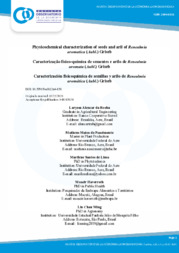Physicochemical characterization of seeds and aril of Renealmia aromatica (Aubl.) Griseb.
Physicochemical characterization of seeds and aril of Renealmia aromatica (Aubl.) Griseb.
Autoria: ROCHA, L. A. DA; NASCIMENTO, M. M. DO; LIMA, M. S. DE; HAVERROTH, M.; MING, L. C.; ARAGÃO JÚNIOR, A. C. DE; TORRES, N. S.; FERREIRA, A. B.
Resumo: The Amazon has great biodiversity, being inhabited by indigenous peoples since time immemorial, as well as being home to traditional farmers, settlers, riverine dwellers, people responsible, in large part, for the conservation of biodiversity through the cultivation and storage of grains, tubers, roots and seeds. Among the numerous species cultivated and managed by the Amazonian peoples, we approach, in this work, the species Renealmia aromatica (Aubl.) Griseb., belonging to the Zingiberaceae family. The objective of this article is to present physicochemical aspects of the fruits of Renealmia aromatica (Aubl.) Griseb. aiming to emphasize its alimentary potential and nutritional value.This work consisted of harvesting the fruits of mother plants located in the experimental garden of the Universidade Federal do Acre – UFAC. The analyzes were carried out at the Unidade de Tecnologia de Alimentos – Utal of UFAC – Campus Rio Branco. The variables analyzed were protein, ascorbic acid (vitamin C), titratable acidity, moisture and ash (fixed mineral residue) according to the methods for physicochemical analysis of foods from the Instituto Adolfo Lutz. In the aril and in the seed, protein contents of 7.97% and 6.67% were found, respectively. As for lipids, the highest concentration was observed in the seeds, with a content of 6.76%. The aril showed a satisfactory level of vitamin C (182,81 mg/100g). With a high concentration of lipid, the seeds had a total caloric value of 335,56 kcal/100g. Thus, the seeds and arils of R. aromatica have alimentary and nutritional potential, being the seeds used for the production of edible oil or condiment, and the aril, rich in vitamin C, used in alimentation. This, although already used in food, is still restricted to indigenous peoples and traditional communities.
Ano de publicação: 2024
Tipo de publicação: Artigo de periódico
Unidade: Embrapa Alimentos e Territórios
Palavras-chave: Arilo, Condimento, Planta Medicinal, Planta alimentícia, Renealmia aromatica, Semente, Óleo comestível
Observações
1 - Por padrão são exibidas publicações dos últimos 20 anos. Para encontrar publicações mais antigas, configure o filtro ano de publicação, colocando o ano a partir do qual você deseja encontrar publicações. O filtro está na coluna da esquerda na busca acima.
2 - Para ler algumas publicações da Embrapa (apenas as que estão em formato ePub), é necessário ter, no celular ou computador, um desses softwares gratuitos. Sistemas Android: Google Play Livros; IOS: iBooks; Windows e Linux: software Calibre.
Acesse outras publicações
Acesse a Base de Dados da Pesquisa Agropecuária (BDPA) para consultar o acervo completo das bibliotecas da Embrapa.

